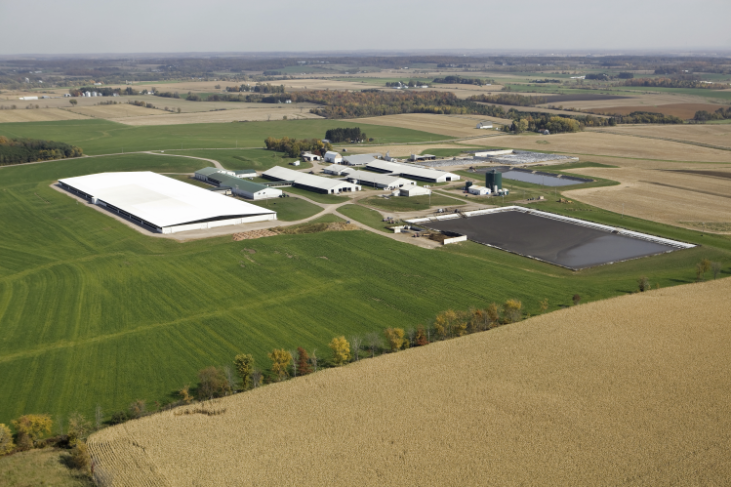June Dairy Month might be over, but the work to safeguard the future of animal agriculture and its value to society by bridging the communication gap between the farm and food communities is not. Farmers, companies, organizations and others are always working to build bridges and set the record straight about dairy. However, we always need more voices to join the conversation. Here are just a few examples of the great work being done and how you can get more involved in these efforts.
1. One thing everyone has learned in the last year is how essential virtual engagement is and will likely continue to be, even as we transition back to a new normal. American Dairy Association North East launched their Virtual Farm Tour program in 2018 to virtually connect students to farmers for real-time interactions. So, when the COVID-19 pandemic forced the cancellation of in-person activities of all types,
ADA North East was ready. With a library of virtual farm tour recordings for consumers, they immediately made them available as “edutainment” for families stuck at home. They also had technical knowledge and a litany of best practices to train farmers on how to “go live” from the farm.
2. Emily Johannes, senior manager of sustainable sourcing at Nestle, spoke at the Animal Agriculture Alliance’s 2021 Virtual Stakeholders Summit on a panel about what companies and organizations can do to promote and protect animal agriculture. Johannes talked about Nestle’s pledge to achieve net-zero greenhouse gas emissions by 2050 and investing more than $3 billion in agriculture to help them reach their goal because, as she said, “We believe agriculture is the solution and not the problem.” She went on to explain how Nestle is partnering with farmers and ranchers to support regenerative agriculture to reduce the carbon footprint in dairy and beef because “they are so vitally important to our business.”
3. Farmers for Sustainable Food (FSF) is a newly renamed five-year-old nonprofit that connects farmers, processors, environmental groups, scientists, food companies, community leaders and agricultural businesses to share ideas and collaborate on projects. FSF supports a growing number of farmer-led watershed conservation initiatives in Wisconsin, encompassing 211 farms, 300,000 acres and 212,000 livestock.
The organization and its partners are also developing on-farm initiatives around the Midwest to test ways of measuring sustainability and documenting the impact of conservation practices, both environmentally and financially..
4. A good communicator knows that to reach outside of the agriculture echo chamber, you have to talk about more than just dairy cows. Emily Shaw, also known online as Dairy Girl Fitness, marries her passions for fitness and dairy together, an approach that has earned her nearly 23,000 Instagram followers. Consider what passions you have outside of agriculture because starting conversations on common interests and then weaving in your passion for dairy, or letting the person come to find out about your love of dairy on their own, is a great way to lay the foundation for meaningful engagement.
5. Showing up in unexpected places is also a great way to reach new audiences. Tara Vander Dussen, a dairy farmer and environmental scientist known online as New Mexico Milkmaid, was a guest on The Weather Channel in May sharing dairy’s commitment to reducing its environmental footprint.
6. Farmers Jess Peters and Maureen Lemos recently authored children's books about dairy cows. Peters published her book titled The Confused Cow with the goal of showing farms as they are now. In a Facebook post, Peters said, “You won’t find a little red barn on a little green hill with a farmer wearing a plaid shirt, overalls and a straw hat. I think it’s time that even kid’s books showed the world as it is.” Lemos’ book, Clarice the Red Cow, shares the friendship of a cow named Clarice and the author Maureen, illustrating how much farmers care about their cows. You can order the books to gift to a family you know or donate to your local school or library to help youth learn about dairy.
7. The United Nations is convening a Food Systems Summit (FSS) later this year as part of its “Decade of Action” to achieve the Sustainable Development Goals that were adopted by all U.N. member states in 2015 as part of the 2030 Agenda for Sustainable Development. The Alliance hosted an independent dialogue event bringing together 125 stakeholders across the U.S. animal agriculture community to make sure the perspective of U.S. animal agriculture was communicated to FSS leadership and other key audiences.
The National Dairy Council and U.S. Dairy Export Council also hosted an independent dialogue partnering with The Nature Conservancy and the Global Child Nutrition Foundation to host a dialogue that included dairy’s essential role in sustainable food systems. Agriculture organizations are currently preparing for the Pre-Summit of the FSS, which will be held July 26-28 in Rome and virtually.
8. College students from across the country who are passionate about animal agriculture have competed in the Alliance’s College Aggies Online scholarship competition since 2009. One of their challenges is to host an “Undeniably Dairy” event on their campus to share the nutritional benefits of dairy and how dairy is produced with students who may not be familiar with agriculture. The 2021 competition kicks off on September 13, and students interested in participating can sign up here.
To elevate your communication and advocacy skills so you are always ready to help safeguard the future of animal agriculture, sign up for Animal Ag Allies – a development program that empowers farmers, ranchers and practicing veterinarians to be outspoken advocates for agriculture online and within their communities. The program consists of two phases: online training and a private forum to discuss engagement strategies and emerging issues. Sign up and learn more here.




